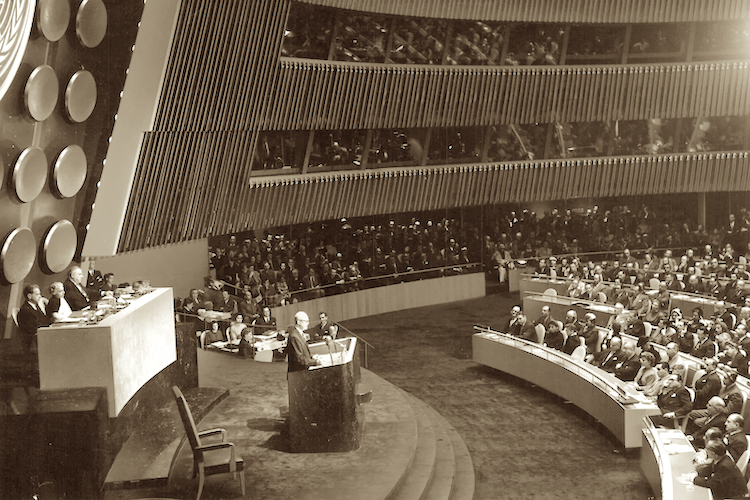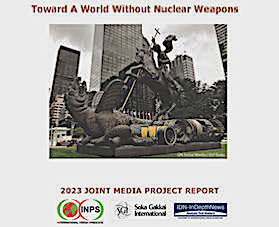70th Anniversary of President Eisenhower’s Speech on “Atoms for Peace”
By Leonam dos Santos Guimarâes
*The writer is a Nuclear and naval engineer (PhD) member of the Brazilian National Academy of Engineering. CEO of Eletronuclear S.A. Coordinator, Brazilian Navy Nuclear Propulsion Program.
RIO DE JANEIRO | 23 October 2023 (IDN) — On 8 December 1953, the President of the United States, Dwight D. Eisenhower, delivered a speech before the United Nations General Assembly that would echo through the pages of history. (P 20) JAPANESE | SWEDISH
This speech, “Atoms for Peace,” marked a crucial shift in how the world viewed nuclear energy and its applications. In this speech, Eisenhower outlined his vision for the peaceful use of atomic energy and the promotion of international cooperation in nuclear energy. In 2023, we celebrate the seventieth anniversary of this emblematic speech that highlighted the need to use nuclear science’s power to benefit humanity.
The historical context of this speech was crucial since the US had dropped the atomic bombs on Hiroshima and Nagasaki at the end of World War II, marking the beginning of the nuclear age. The world was keenly aware of the dangers associated with nuclear energy, and the Cold War was at its height. Nuclear weapons have become a symbol of power and a threat to the survival of humanity. Eisenhower, a decorated World War II general who commanded Allied troops in the recapture of Europe, understood the destructive potential of nuclear energy, but he also envisioned its potential for civilian uses. The speech was an attempt to change the course of history by emphasizing the commitment to the peaceful use of nuclear energy.
The central concept of the “Atoms for Peace” speech was sharing nuclear knowledge and technology with other nations, as long as it was for non-explosive purposes. Eisenhower recognized the potential of nuclear energy not just as a threat but as an opportunity for global benefit
In his speech, Eisenhower expressed his vision of a world where nuclear energy could be a force for good. He proposed the creation of an international agency that would oversee the peaceful use of nuclear technology and promote global collaboration. The President of the United States emphasized that nuclear knowledge should be shared to promote nations’ economic development and well-being, bringing progress to all humanity.
Eisenhower’s speech also highlighted the importance of nuclear disarmament and the need to control the proliferation of nuclear weapons. He urged other nations to join in the effort to ensure that nuclear energy was used exclusively for peaceful purposes, which led in just over a decade to the Treaty on the Non-Proliferation of Nuclear Weapons (NPT).
Eisenhower’s speech led to the creation of the International Atomic Energy Agency (IAEA) in 1957, an organization dedicated to promoting the peaceful use of nuclear energy and monitoring its use to ensure it is not diverted for explosive purposes. The IAEA has since played a crucial role in supervising and regulating nuclear activities around the world, contributing to the prevention of the proliferation of nuclear weapons by verifying the commitments made by NPT member states.
As we celebrate the 70th anniversary of the “Atoms for Peace” speech, it is important to highlight the significant advances in the peaceful application of nuclear energy over seven decades. Its concept brought to light the idea of using nuclear energy for the benefit of medicine, industry, agriculture, and generation of clean electrical energy, without emission of harmful gases into the atmosphere, and heat for use in various production processes, such as desalination and hydrogen currently called “blue”, so crucial for the current energy transition and climate change mitigation.
Nuclear applications have since led to the development of advanced medical technologies, such as radiotherapy for the treatment of cancer, and enabled the production of radioactive isotopes for diagnosis and therapy of broad spectrum diseases. Food irradiation techniques significantly reduce losses in the logistics distribution chain. These techniques are also applied to the sterilization of medical and surgical material and even in the preservation of works of art.
Furthermore, nuclear energy has become an important source of electricity supply in many countries, exceeding 50% of generation in some such as France, Slovakia and Ukraine, thus contributing to the diversification of sources and energy security.
Small modular nuclear reactors (SMR) open up broad prospects for cogeneration for non-electrical uses with direct use of the heat generated for industries such as steel, aluminum, cement and the production of synthetic fuels, as well as generation units in remote locations such as the oceans, whether fixed on the seabed or floating, and in space, whether for rocket launcher propulsion or for electrical generation.
internal to space vehicles and even fixed to celestial bodies closer to Earth, such as the Moon and Mars. Add to this the accelerated development of digitalization and artificial intelligence that requires data centers with increasingly greater decarbonized generation powers, with extremely high reliability and continuous availability, without interruptions or intermittency.
Today, as we celebrate the anniversary of Eisenhower’s speech, it is important to reflect on his legacy and the progress that has been made since then. The IAEA continues to play a crucial role in overseeing nuclear activities around the world, promoting nuclear safety and international cooperation. The peaceful applications of nuclear energy continue to benefit humanity by improving the quality of life and driving scientific advances.
However, it is crucial to remember that challenges associated with nuclear energy also persist. Nuclear safety, radioactive waste management and the non-proliferation of nuclear weapons remain global concerns. It is a constant reminder of the need for international cooperation and the responsible application of nuclear technology.
President Eisenhower’s 1953 speech remains a powerful warning of the potential of science and technology to shape our future. He urged us to use nuclear energy responsibly and to seek peace in a world marked by the threat of nuclear weapons. Today, we honor that vision and reaffirm our commitment to promoting the peaceful use of nuclear energy for the benefit of all humanity.
As we celebrate this anniversary, we must reflect on the legacy of the “Atoms for Peace” speech and reaffirm our commitment to the peaceful use of nuclear energy. Eisenhower’s speech remains an inspiration for promoting peace, security, and cooperation in a world where nuclear energy plays a significant and potentially growing role in the energy transition.
Ultimately, Eisenhower’s “Atoms for Peace” is a reminder that science and technology can be used for the good of humanity, provided there is a continued commitment to responsibility and international cooperation. It continues to be an important milestone in the history of nuclear diplomacy, highlighting the importance of using nuclear knowledge for peace and development to achieve the UN’s sustainable development goals (SDGs). [IDN-InDepthNews]
Photo: Dwight D. Eisenhower delivering the famous Atoms for Peace speech at the UN General Assembly on 8 December 1953.













